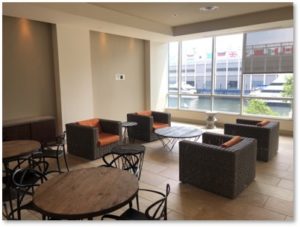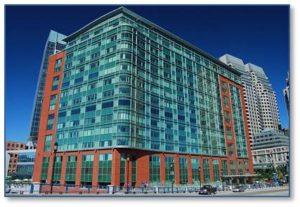Walking around Boston, you sometimes encounter areas known as Privately Owned Public Spaces, or POPS. These privately owned and maintained spaces have been created through the Boston Planning & Development Agency’s development review process.
While the public is encouraged and invited to enjoy these places, that invitation is often understated to the point of being invisible. In fact, many are more secret than public and for an obvious reason. As Reneé Loth explained in the Boston Globe, the POPS have been hiding in plain sight because:
“Property managers don’t want the rabble wandering through their sleek lobbies or snoozing on their benches, so they post minuscule signs or expect visitors to rely on ESP to find them.”
Finding the Privately Owned Public Spaces
How do you find these Privately Owned Public Spaces? Some are well-known to pedestrians because they masquerade as building lobbies, public parks, and segments of the Harborwalk.
The Boston Planning and Development Agency maintains a web page that lists some of them, including an interactive map with thumbnail photos. You can sort by type: Harborwalk (28), Plaza (8), Green Space (4), and Interior Space (3).
This page doesn’t include other familiar POPS like the beautiful Post Office Square Park (private developer) or the Seaport’s Lawn on D (a quasi-public space owned by the Massachusetts Convention Center Authority). In other words, it doesn’t cover the entire city, so it’s not comprehensive.
Across the river, the Cambridge Redevelopment Authority maintains its own website that not only details the POPS in the Kendall Square MXD District but gives a lot more information as well. The Cambridge Community Development Project has its own, much less user-friendly, website with maps of POPS but no photos.
Protecting the Harbor
The Harborwalk has so many more POPS listed because our Puritan forebears thought that the waterfront shouldn’t be owned by any individual. To that end, Chapter 91—the city’s Public Waterfront Act—requires that every piece of property on the Boston waterfront has to have at least one element that’s accessible to the public.
Thus, two lawns and a section of the Harborwalk are actually privately owned and the Hotel Intercontinental blocks them off frequently for outdoor dining or private parties. The hotel violates their Waterways License every time they do it. When a hotel can rent out four hours of a POPS greenspace for $2,000 and not have to pay a hefty fine, the decision is pretty simple.
What, you thought that just because the Harborwalk was publicly owned and protected by the Waterways License you could walk its length any time? Think again. The city could collect fines when there are infractions and use the money to invest in more public spaces, but that would require resources to monitor the POPS.
Finding Boston’s POPS
So, how do you find all of Boston’s POPS — the non-musical ones, that is? You do some research both online and on foot. As Ms. Loth reported, neither the developers nor the city make it easy.
No public list exists of all Boston’s POPS; neither is there a comprehensive website. Way back in 2015, the Boston Society for Architecture (BSA) called for a compilation of POPS around the city. One of them is the BSA Space, an airy atrium in their building at 290 Congress Street—complete with public restrooms. Alas, that web page still does not exist.
That same year, Petra Geiger in the Red Thread News called for a catalog of POPS. Prof. Jerold Kayden, Harvard Professor of Urban Planning and Design gave a lecture on the subject to the university’s Graduate School of Design and was interviewed on WBUR Radio. He also called for a compilation of POPS around the city. The response in the last five years? Crickets.
If there has been a demand, why has there been no response? I can only assume it’s because no one has been given the job of compiling this list. You know the old saw: If it’s everyone’s job; it’s no one’s job. And No One has tackled it assiduously for the last five years.
Other Posts on POPS
I have published blog posts about a few of the POPS that I have investigated, although some of it took some doing. Given development around the city and controversy over some of the POPS, especially in the Seaport District, I thought the subject worth revisiting. The non-existent POPS list is growing with all the new buildings going up.
I actually started this post as the introduction to another well-hidden POPS that I visited last weekend. That will appear next week.
- Foster’s Rotunda at the Boston Harbor Hotel — The hotel has closed this former POPS to the public and converted it to a $15,000-a- night hotel suite. The new POPS is a ground-floor remnant space.
- Independence Wharf’s Observation Deck
- Boston’s Not-So-Public Spaces




